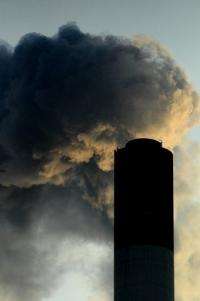Plump up the clay: Carbon dioxide moves into and expands a common mineral in carbon sequestration caprocks

(Phys.org) -- For the first time, scientists have direct evidence that high-pressure carbon dioxide or CO2 migrates into the clay montmorillonite causing it to expand, according to scientists at Pacific Northwest National Laboratory. Montmorillonite is found in the rocks used to cap carbon sequestration sites, and scientists previously thought that only water could make it expand. Caprocks spend thousands of years halting the escape of injected CO2. To learn how these rocks respond to CO2, the researchers studied the material under realistic sequestration conditions.
"Our goal is to eventually be able to predict how a caprock will respond to CO2 containing variable amounts of water," Dr. John Loring, a PNNL chemist and materials scientist who led the study.
Producing power with fossil fuels accounts for just over half of the planet's human-made CO2 emissions, and that number is rising. These emissions are altering the climate, changing weather patterns, and affecting cities and crops. Reducing emissions by storing them in underground locations could ease these changes. By understanding the fundamental reactions, including those of caprocks, scientists can inform industry and the public about the cost and safety of different options.
While the concept of a carbon sequestration caprock is relatively simple, the chemistry provides intriguing "what ifs." Scientists are answering these scenarios by studying how different aspects of the rock respond to different situations. These situations revolve around supercritical CO2, which behaves a bit like a liquid and a bit like a gas. Carbon dioxide will exist in this supercritical form at the underground depths where it is to be stored.
One question that arises is: what happens when the rock encounters the buoyant supercritical CO2 that was pumped into the well? Supercritical CO2 can be "wet" or "dry." The wet version contains water that has co-mingled with the pollutant. The dry version contains no water. The team at PNNL tackled what happened when both versions contacted montmorillonite.

Found in veins crisscrossing some caprocks, montmorillonite is well known to expand when it encounters water. In carbon reservoir caprocks, veins of the material could swell shut, possibly preventing the escape of CO2.
However, the team was intrigued by an unusual result. Todd Schaef and his team put the clay in a small sample cell, pressurized the sample with CO2 to reservoir conditions, and interrogated it with x-rays. Using the x-rays, they measured the distance between atoms in the clay. They found that clay puffed up, and this time, water was not the culprit.
"We believed right away that the CO2 was going into the structure," said Schaef. "And, we knew this type of mineral and CO2 interaction was not being accounted for in modeling scenarios for carbon sequestration."
The team turned to two techniques designed to confirm that CO2 was expanding the clay from the molecule's point of view: magic angle spinning nuclear magnetic resonance spectroscopy and attenuated total reflection infrared spectroscopy. These instruments describe the reactions between the supercritical CO2 and the clay at the warm temperatures and higher pressures found in a carbon repository, nearly a mile underground.
"We wanted direct molecular evidence from the point of view of the CO2 itself," said Loring.
The team got their evidence. The data, gathered in record time, showed that CO2 molecules move into the clay. This behavior was not seen in the control clay, which did not expand when it encountered the supercritical CO2.
The team will measure the amount of CO2 that can be held by the montmorillonite and determine how the CO2 gets in. They will measure the update with varying amounts of water, getting the details needed to allow accurate predictions of caprock performance. They'll also be looking at four other components of caprocks.
"This is the beginning of our research efforts in caprock performance," said Schaef. "We are looking at the fundamental processes that will allow us to retain CO2 for several thousand years."
More information: JS Loring, et al. 2012. "In situ molecular spectroscopic evidence for CO2 intercalation into montmorillonite in supercritical carbon dioxide." Langmuir 28(18):7125-7128. DOI: 10.1021/la301136w
Journal information: Langmuir
Provided by Pacific Northwest National Laboratory
















